How to balance the spirit of craftsmanship and making money in the operation of cafes?
Follow the caf é (Wechat official account vdailycom) and found that Beautiful Cafe opened a small shop of its own.
The popularity of China's boutique coffee market continues to rise. This year, Starbucks' first overseas baking experience store will open in Shanghai (as previously reported in Huazhi: Starbucks' first overseas and largest roaster coffee shop in the world will open in Shanghai and open next year!). Before that, boutique coffee in Shanghai has become popular: independent cafe brands such as Lumazi, quality Hall, Malone, Seesaw and Lutianjia have gradually stepped out of the niche and opened their stores to the core business district where the flow of people is more dense; at the beginning of 2017, S ENGINE (Eagle set Coffee) and GREYBOX, with large capital support, have successively become new players breaking into the boutique coffee market in Shanghai and Beijing.
At the same time, instant coffee still occupies a huge market share, and many consumers still go to nearby supermarkets to buy instant coffee for only a few yuan each. Cafes in most Chinese cities do not open until after 9 a.m. Even so, more and more Chinese consumers are used to the imported coffee culture and are gradually accepting the high prices and complex tastes of boutique cafes.
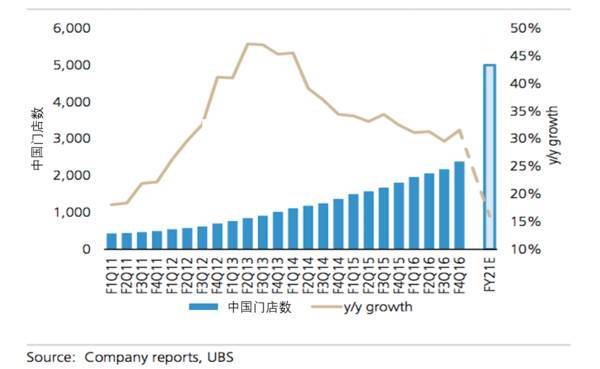
But does this mean that the hot spot of boutique coffee in the Chinese market has come?
The growing Chinese coffee market
Since Shangdao Coffee entered Hainan and Guangdong in 1990, the Chinese coffee market has gradually risen under the cultivation of foreign brands such as Starbucks, Costa and Pacific Coffee. Although China's annual coffee consumption currently accounts for only 2% of the world's total, China's coffee demand has entered a period of rapid growth, with an average annual growth rate of 15% to 20%. According to USDA statistics, China's annual coffee consumption has quadrupled in the past four years, the highest growth rate in the world.
"I wouldn't be surprised if one day the total number of Starbucks stores in China surpasses that of the United States." Starbucks CEO Howard Schultz said at the Starbucks Global Summit last May.
As of the first quarter of fiscal 2017, Starbucks had 2543 stores in China, according to public data from UBS. In the eyes of Chinese mainland, China is undoubtedly the company's most important overseas market, and the company plans to open 500 new stores in each of the next five years, and achieve the goal of operating more than 5000 Starbucks stores on Starbucks by 2021. Meanwhile, Dunkin' Donuts, Starbucks' main North American competitor, announced last year that it would open 1400 new stores in China over the next 20 years, doubling the number of existing stores.
Fine coffee is still a spark in China.
Illy Coffee Global CEO Andrew Illy predicted, "in China, the popularity of coffee culture precedes coffee consumption, which is very interesting, and sooner or later it will be combined with consumption." If coffee becomes a part of Chinese people's daily life, then coffee consumption will really rise. "
Today, the term "boutique coffee" on the market mostly refers to brands affected by the "third wave of coffee" (Third wave of coffee). Boutique coffee is a general concept. Compared with the unique meaning contained in its English name Specialty Coffee, its Chinese translation pays more attention to the "premium" given by the uniqueness of the product.
The concept of "boutique coffee" was first put forward by Erna Knustsen, founder of the American boutique coffee association SCAA (Specialty Coffee Assocaition of America) in 1974. Boutique coffee will emphasize the origin of raw materials, using medium and shallow roasting to emphasize its taste and layering, and often use hand-flushing, dripping and other methods in production, hoping to maximize the original flavor of coffee. After the coffee industry evolved into a "third wave of coffee"-following instant coffee and freshly ground coffee chains, some consumers began to chase "better coffee".
Making coffee like wine, the first three typical coffee shops that represent the "third wave of coffee" are "intellectuals", "Tree Pier City" and "counter-culture". But better known is Blue Bottle, which is sought after by Silicon Valley venture capital, which has so far raised a total of $120 million (see Huazhi: Blue Bottle, a high-end Silicon Valley artisan coffee, has completed its latest round of financing of $70 million).
It is generally believed that the Chinese market for boutique coffee started in 2012, when the number of cafes in China exceeded 30,000.
According to the latest analysis by UBS, 78% of Chinese coffee drinkers buy freshly brewed coffee at least once a week, while only 61% of American coffee drinkers do so. Of course, the base of Chinese coffee drinkers is much smaller.
Compared with the acceptance of boutique coffee in American society, domestic boutique coffee consumption has just begun to sprout. According to the results sorted out with reference to Dianping's data in the New first-tier cities feature of China Business Weekly, there are currently 5296 cafes in Shanghai, of which 3257 are independent cafes, many of them under the banner of "boutique". Since 2012, the domestic boutique coffee industry has entered the second stage of capital-driven scale development by operating a "small and beautiful" store separately and independently. At a time when the comprehensive operating costs of physical stores are increasingly high, chain stores are still the first choice for foreign and local boutique coffee brands to enter the market.
Is opening a boutique cafe a "high-cost, low-yielding" business?
Behind a cup of boutique coffee is actually a complete industrial chain that includes planting, raw bean trade, baking, chain stores and surrounding fast consumer goods. As the brand marketing of boutique coffee needs to maximize its uniqueness, the cafe provides a window to show the background story of coffee beans, coffee production technology and, more importantly, the interaction between baristas and customers. But usually, any coffee shop that can provide a high-quality, fresh, acceptable and competitive cup of coffee is a boutique coffee shop. But opening a boutique coffee shop is not as easy as it seems.
What are the costs of a boutique cafe?
Coffee beans with stories are only the first step.
Traceability is the guarantee of the uniqueness of fine coffee. For boutique coffee, there is a "4321 theory" that 40 per cent of the quality of a cup of boutique coffee lies in the variety, planting and handling methods, 30 per cent in roasting, 20 per cent in the equipment used for brewing, and 10 per cent in the brewer's technology.
As a result, most baristas with their own brands look for and cooperate with coffee beans that have a unique flavor and match the target market in coffee plantations around the world. In the international production of raw beans, the proportion of high-quality coffee beans is about 2%, but this number is growing. On February 22, Starbucks' 2017 trip to Yunnan coffee origin was launched in an all-round way. It is reported that Starbucks' first coffee bean from a single producing area in China, Starbucks Yunnan Coffee Bean, went on sale in Starbucks stores in China earlier this year.
The "origin price" of boutique coffee beans usually ranges from US $10 to US $several hundred per kilogram (the futures price of international coffee beans fluctuates at any time, subject to the same-day price), plus transportation, customs clearance fees, and so on. the price is usually more than 100 yuan per kilogram.
Good individual coffee, in addition to the quality of coffee beans themselves, but also go through three processes of processing, baking and extraction, all of which require superb craftsmanship. The yield of high-quality beans is not as stable as that of commercial beans, and beans from different seasons and places of origin need different treatment methods. This makes it more difficult to deal with and increases the importance of baristas.
At present, the purchase frequency of coffee beans in domestic boutique cafes is affected by the limited number of coffee beans sold in a boutique coffee shop (the number of cups sold in a boutique coffee shop is usually less than 100 a day), and it is still unable to purchase coffee beans every week, so the freshness of coffee beans is greatly affected.
Baking is the key to differential competition and the hardest hit area of cost.
The more high-quality coffee, the greater the room for manoeuvre in roasting, different roasting degrees are likely to produce a good taste spectrum to meet the increasingly personalized needs of consumers.
Commercial coffee is usually deeply roasted and roasted in large quantities in large ovens. Deep baking can extend the shelf life, allowing beans to be stored for a longer time, and sometimes preservatives are used to extend the shelf life to 1 Mel 2 years. The shelf life of medium and shallow roasted coffee beans is short, and the fresh state can show the particularly valuable bright acidity and clean fruit aroma in some producing areas. Such fine coffee requires fresh baking, grinding and drinking, and coffee beans baked within a month are the best. So commercial coffee retailers can buy coffee beans from coffee roasters, while boutique coffee often directly buys raw coffee beans and roasts them themselves.
As for the bean dryers that are increasingly found in boutique cafes, they are not necessarily standard in cafes. The price of the roaster ranges from tens of thousands of yuan to more than 200,000 yuan. The capacity of the roaster ranges from 200-300 grams to dozens or even hundreds of kilograms, while the roasting capacity in general cafes is often less than one or two kilograms at a time. Individual coffee beans are still easy to explore on their own, but for mixed beans, the requirements for roasters and roasters are higher. Compared with our own baking, the professional baking plant is more cost-effective and stable.
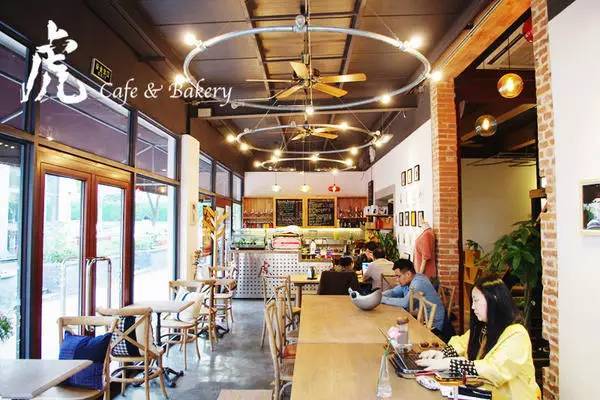
Image above: Tiger Coffee has been opened in three stores and coffee beans have been bought from Barista King, which is baked by Zhou Yungui, a famous barista in Shanghai.
Star barista or coffee industry newcomer?
China's boutique coffee industry, like many other industries, faces a "people" problem-a shortage of baristas and middle management personnel. It can be said that at present, all the boutique cafes that have opened chain stores in China are held by the champion baristas who have won all levels of coffee roasting, brewing or flower-pulling competitions at home and abroad. The team of star baristas can not only improve the quality control and R & D system of the brand, but also attract public attention and stimulate traffic.
However, people are moving. After Huang Junhao, the chief barista and the international referee of China's first COE coffee competition, left office, the quality restaurant coffee, which once sold 1010 yuan a cup of hand-made coffee, had to change the chain's strategy to reduce the product's dependence on "people".
Bar "equipment contest"
Inside the cafe, the core area is the bar where baristas make coffee. For the bar, the investment in equipment requires operators to be mentally prepared. Leaving aside the technical level of baristas, if you want to achieve high-quality products, a boutique cafe's investment in coffee machines and bean grinders is about 100,000 yuan.
Even in the boutique coffee industry, the common truth is "one penny for every penny, two cents for two cents, and three cents for three cents." the higher the quality, the smaller the difference in quality, but the higher the input cost. CEO Wang Juntao, founder of S ENGINE Coffee, admitted that the Shanghai Xintiandi store also spent about 900000 on building a bar-including MAVAM, China's first limited edition embedded coffee machine, Slayer with pre-soaking function and EK43 called the king of hand brewing.
Boutique coffee brands are trying to increase returns.
In the boutique coffee industry, the place where operators often take it lightly is how to convey their ideas and messages to consumers. Many operators and baristas have done a lot of homework and efforts, because coffee is an imported culture rising from the ground in most parts of China, and guests' demand for coffee is not limited to the product itself, so patient promotion and marketing is a must for businesses. and the dissemination of knowledge and experience can make consumers drink more clearly and the consumption experience more interesting. The spread speed of the product itself will be relatively slow, and a boutique coffee shop can provide detailed information, including the manor, the way it is handled, the degree of roasting, and so on, by designing table cards and menus, holding tasting meetings and cup testing meetings. show the meaning and value behind a cup of coffee.
1) enter the retail channel and enter the younger market
Earlier this year, Shudun City, the American cafe that represents the "third boutique coffee wave", launched a new product line that sells three flavors of canned sparkling cold coffee (sparkling cold brew), including original, ginger, citrus and lemon honey. The revision of packaging is to a large extent to reach more consumers. These canned drinks will not only be placed in a small number of Shu Dun Shing Men stores, but will also be introduced into retail channels and spread across the United States. The move is also seen by the industry as inspired by Blue Bottle, which last year pioneered "New Orleans Ice Coffee", which is packed in cartons and cooled for 18 hours with organically roasted beans.
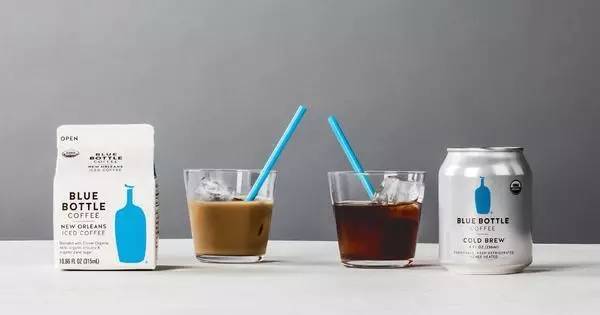
Image above: Blue Bottle New Oreans,iced coffee entering the retail channel
Similarly, Never Coffee, which entered China's boutique coffee market through online channels in 2015, launched canned boutique coffee at a low price of 9.9%. Last year, the brand launched three more products offline: ice-brewed black coffee, ice-brewed lime coffee and ice-brewed latte, with terminal prices of 12.8 yuan, 12.8 yuan and 14.8 yuan, respectively. Among them, black coffee, which is best known by fans, rose 2.9 yuan.
2) store design, strengthen interaction and highlight theme
At the end of December 2016, GREYBOX opened its first store on the first floor of the International Trade Center in Beijing. Its founder was Puyi, who successfully created the high-end love token brand roseonly. In the open coffee space with less than 80 square meters of GREYBOX, the minimalist industrial style created by log and metal materials is reminiscent of Silicon Valley geeks who are constantly driving the cultural iteration of coffee trends. Puyi told Huanlizhi that GREYBOX targeted TWG (a high-end tea brand founded in Singapore) and Milan's Cova (a classic Italian cafe with a history of more than 200 years), so it opened its stores to upscale shopping malls in the same location as luxury brands, and the stores were small and beautiful, and roseonly's operating experience gave it a great channel advantage.
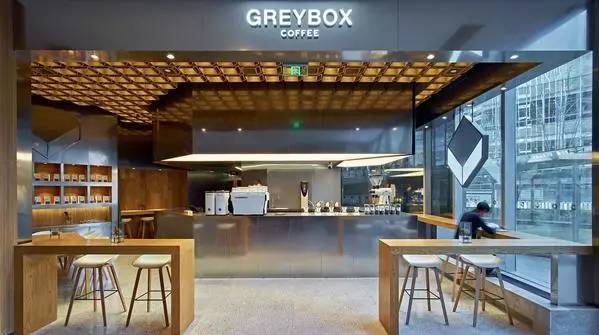
Image above: GREYBOX Beijing Kerry Center store
Seesaw, which wants to be the most authentic Australian boutique coffee in China, has two main design requirements when it is the first Shanghai Yuyuan store: first, the bar is as open as possible, so that customers can see the whole coffee making process clearly and communicate with the staff at any time; second, the bar should be like the stage, through the poor line of sight of the seating area, so that customers can sit and watch the barista's performance like a show.
The choice of theme for boutique coffee can be very free, but it must be accurate. The tragedy of "digression" is often accompanied by catering, so catering has become a tangled problem in many cafes. The per capita consumption and turnover rate of boutique cafes are no better than those of ordinary restaurants, but their labor and rent levels are often not much different. To ensure the accuracy of the theme positioning, in addition to balancing the proportion of services provided, there is also the coordination of the overall design. For example, the way of setting the plate of western food and the aesthetics of light food make some irrelevant things merge in the space of the cafe. Boutique cafes need to use all the details to reflect the quality of coffee, including cutlery, flowers, music, clothing and so on, so design is also a threshold for boutique coffee shops.
3) develop peripheral products and create consumption scenes.
Selling coffee alone may not be enough to support rent and labor, so value-added service is another big issue for boutique cafes to consider. Regardless of the size of the business space, the number of customers, as long as there are professional baristas, hand cups test more than 80 points of beans, is a boutique coffee shop. In such a propositional open space, selling products around coffee, such as coffee machines, cups and saucers, or products related to the space theme itself, such as clothing and accessories, are ways for cafes to increase turnover and optimize consumption experience.
Baristas should also be salesmen for these products. Wang Juntao believes that the reason why the surrounding products of many coffee shops are not sought after all the year round is that they do not have a good consumer guidance. For example, when a customer enters the door, he sees the barista grinding beans, and the next step is to try it; when the customer recognizes the taste, he may buy a coffee utensil-after all, professionals don't usually buy equipment in coffee shops.
4) refine the division of labor and find suitable suppliers
The industrial chain of boutique coffee will have more and more fine division of labor with the development of its specialization. In the face of the general difficulties of "thin profits and high costs", operators pay more attention to store operation and marketing. Raw material procurement, coffee bean baking, barista training, coffee shop design and other work will increasingly be outsourced to other teams.
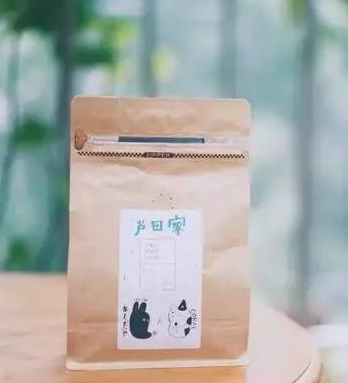
Image above: the Lutian family who has settled in the e-commerce platform "A Life Pavilion"
At present, the boutique coffee brands with roasted coffee beans as their main business are "Micro-roasting" in Fuzhou, "Lutian Family" in Shanghai and "Uncle Dou" in Beijing.
5) A short window shop may be the next possibility
The next possibility for boutique cafes in China may be smaller coffee windows that sell mainly outside. In Melbourne, a boutique coffee takeout can easily make a profit when it sells about 500-800 cups a day. Last year, Manner Cafe, an independent boutique coffee with an area of only 2 square meters, was included in the Coffee Map of Shanghai written by Huang Junhao. Except that the place is extremely small, the lattes here are 15 yuan for small cups and 20 yuan for large ones. The sun Yega single item is also sold at the same price. In addition, there is a reduction of 5 yuan for bringing coffee cups and 18 yuan for cans for selling coffee beans. Not long after opening, the average daily output of cups exceeded three digits, twice the working day of the general boutique coffee shop. However, from the perspective of brand construction, window stores are not conducive to the formation of brand awareness.
6) develop the brand on the basis of not losing money
From Mellon Coffee, which has opened 17 chain stores, two of which are in Singapore, to now Eagle Coffee, Wang Juntao has repeatedly stressed the importance of cost control. The cafe has no more than three important costs: the first is the material cost; the second is the rental cost; and the third is the labor cost. Cost, customer unit price, daily estimated flow of people, these items can basically estimate whether the brand will be operating at a loss or profit. Even for brands, the more the number of stores, the more equal the cost of brand marketing and management costs.
Therefore, boutique cafes need fine operation and strict performance management through some basic indicators and data, rather than blindly pursuing the flavor of mixed beans.
After all, for an ordinary person who only wants a cup of coffee, it is a bit complicated to ask TA to refer to the flavor spectrum of coffee flavor wheel, and it is difficult to understand what the number of Eagle means to bake. Therefore, boutique coffee brands need to consider how to further serve the public consumer groups in order to catch up with this wave of brand scale.
Important Notice :
前街咖啡 FrontStreet Coffee has moved to new addredd:
FrontStreet Coffee Address: 315,Donghua East Road,GuangZhou
Tel:020 38364473
- Prev
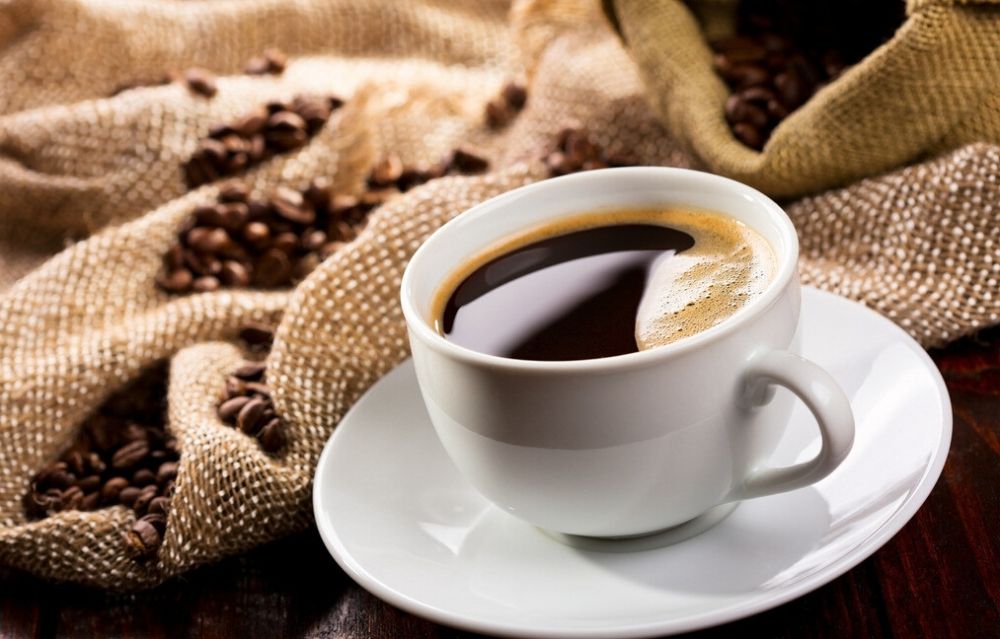
Novice coffee shop location skills, open coffee shop knowledge
Compared with traditional catering, investing in coffee shops is a promising project. Li Ka-shing, the richest Chinese, once said in summing up his real estate investment secrets: lots, lots or lots. The success of investing in coffee shops is also closely related to site selection. Where to open a store and what kind of store to open directly affects business performance. Commercial Wang Street became a cafe
- Next
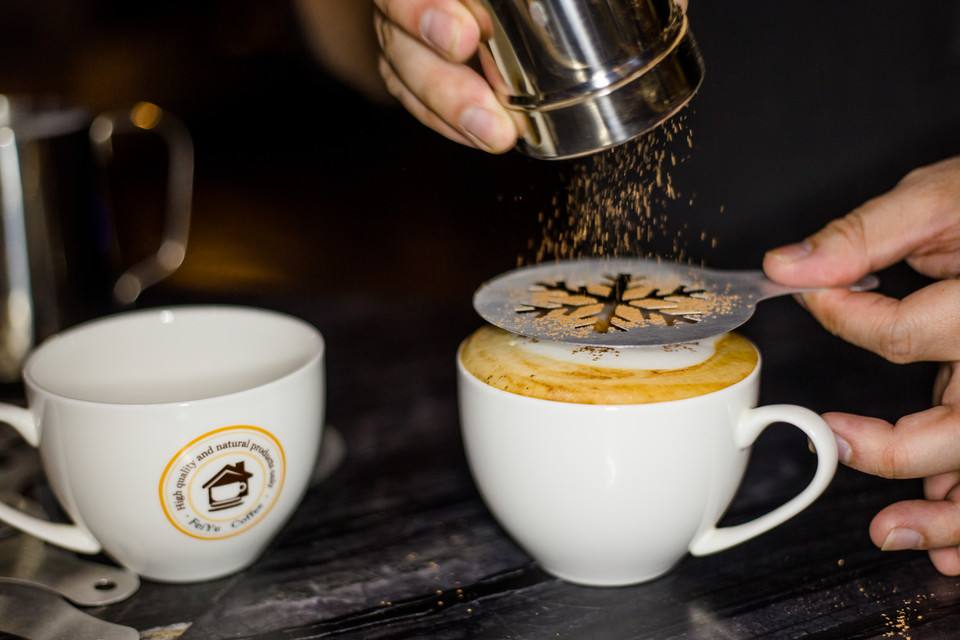
More and more coffee shops in Australia roast their own coffee in order to maintain a competitive edge in the market
It's not difficult to find coffee roasting in-house in a coffee shop in Australia these days, in order to stay competitive in the market and attract more new customers, coffee shops set up coffee beans to roast in-house in order to stay competitive in the market and attract more new customers
Related
- What documents do you need to go through to open a coffee shop? coffee shop coffee shop certificate processing process
- How to purchase Coffee beans in small Cafe how to choose a suitable supplier for domestic Coffee supply Company
- How to drink Starbucks Fragrance White Coffee? how to make Australian White Coffee? what Italian coffee beans are recommended?
- The Story of Flora Coffee: the name of Flora Coffee Bean and the implication of the Flowers on Florna Coffee
- How much does a cup of coffee cost? How much is the profit of a cup of coffee? What is the profit of the coffee shop in a year?
- Yunnan small Coffee, known as "fragrant Coffee", introduces the characteristics of Alpine Arabica Coffee producing areas in Yunnan, China
- 2023 latest Starbucks full menu price list how much is a cup of Starbucks coffee what is better to drink the most popular hot and cold drinks recommended
- Starbucks different kinds of Coffee Price list Starbucks menu 2023 Top Ten Best drinks in Starbucks
- Starbucks Spring praise Comprehensive matching Coffee Bean theme Story Packaging implication and taste description
- The cost of a cup of coffee latte American coffee cost price and selling price

